Di(4-chloro-phenyldiguanido) derivative which is free of potential genotoxicity and a process for reducing the residual amount of p-chloroaniline in said di(4-chloro-phenyldiguanido) derivative
- Summary
- Abstract
- Description
- Claims
- Application Information
AI Technical Summary
Benefits of technology
Problems solved by technology
Method used
Image
Examples
specific examples
General Experimental Conditions
HPLC Method 1:
[0051]HPLCs were acquired on a Waters Alliance 2695 LC system. Column: Kromasil C18, 5 μm, 4.6×250 mm. Flow rate: 1 mL / min. Detector: UV, 254 nm. Mobile phase A: (33:9.5:57.5; v / v / v) 1-octanesulfonic acid sodium salt solution / glacial acetic acid / methanol. The 1-octanesulfonic acid sodium salt solution was prepared dissolving 1.6 g of 1-octanesulfonic acid sodium salt in 330 ml of water and adding 95 ml of glacial acetic acid and 575 ml of methanol. Mobile phase B: methanol. Gradient: 100% A (0-20 min)-85% A (40-65 min)-100% A (70-80 min). Temperature: 30° C. Sample: 10 mg / mL in mobile phase A. Injection volume: 10 μL.
[0052]Approximate Retention Time for chlorhexidine: 25 minutes.
[0053]Approximate Retention Time for p-chloroaniline: 5 minutes.
[0054]Limit of detection (LOD): 3 ppm of p-chloroaniline.
HPLC Method 2:
[0055]HPLCs were acquired on a Waters Alliance 2695 LC system. Column: Nucleosil C18, 10 μm, 4.0 cm×200 mm. Flow rate: 1 mL / min. ...
examples 1-5
Comparative study of purifications of 1,1′-hexamethylenebis[5-(4-chlorophenyl)biguanidine], i.e. chlorhexidine base
[0057]General Procedure. 2.0 g (3.96 mmol) of chlorhexidine [residual content of p-chloroaniline: 776 ppm (HPLC method 1)] was suspended in 5.76 mL (Examples 1, 4, and 5) or in 12.66 mL (Examples 2 and 5) of the solvent. The resulting suspension was stirred 1 h at room temperature. The white solid was filtered and washed with the solvent and wet Chlorhexidine base was obtained. The solid was dried 5 h at 60° C. and dry chlorhexidine base was obtained. The content of p-chloronailine was determined (HPLC method 1). The results are summarized in Table 2 below.
TABLE 2Residual con-Residual Percent-tent of (III)content of age ofin starting(III) in puri-reduc- chlor-fied chlor- tion ofExampleSolventhexidinehexidine(III)ComparativeH2O776 ppm728 ppm 6%Example 1ComparativeIsopropanol / 776 ppm371 ppm52%Example 2H2O 20.2:79.8ComparativeMethanol / 776 ppm553 ppm29%Example 3H2O 25:754I...
examples 6-8
Comparative study of purifications of 1,1′-hexamethylenebis[5-(4-chlorophenyl)biguanidine], i.e. chlorhexidine base
[0058]General Procedure: 2.0 g (3.96 mmol) of chlorhexidine [residual content of p-chloroaniline: 776 ppm (HPLC method 1)] was suspended in 5.76 mL of the solvent. The resulting suspension was heated to reflux temperature and was stirred 1 h. Then, the suspension was cooled down to 5° C. and was stirred 3 h. The white solid was filtered and washed with the solvent and wet chlorhexidine base was obtained. The solid was dried 5 h at 60° C. and dry chlorhexidine base was obtained. The content of p-chloroaniline was determined (HPLC method 1). The results are summarized in Table 3 below.
TABLE 3ResidualResidual Percent-content of (III)content of (III) age ofin starting in purifiedreduction ExampleSolventchlorhexidinechlorhexidineof (III)ComparativeH2O776 ppm899 ppm−16% Example 67Isopropanol776 ppm210 ppm73%8Methanol776 ppm 86 ppm89%
PUM
| Property | Measurement | Unit |
|---|---|---|
| Fraction | aaaaa | aaaaa |
| Fraction | aaaaa | aaaaa |
| Temperature | aaaaa | aaaaa |
Abstract
Description
Claims
Application Information
 Login to View More
Login to View More - R&D
- Intellectual Property
- Life Sciences
- Materials
- Tech Scout
- Unparalleled Data Quality
- Higher Quality Content
- 60% Fewer Hallucinations
Browse by: Latest US Patents, China's latest patents, Technical Efficacy Thesaurus, Application Domain, Technology Topic, Popular Technical Reports.
© 2025 PatSnap. All rights reserved.Legal|Privacy policy|Modern Slavery Act Transparency Statement|Sitemap|About US| Contact US: help@patsnap.com



